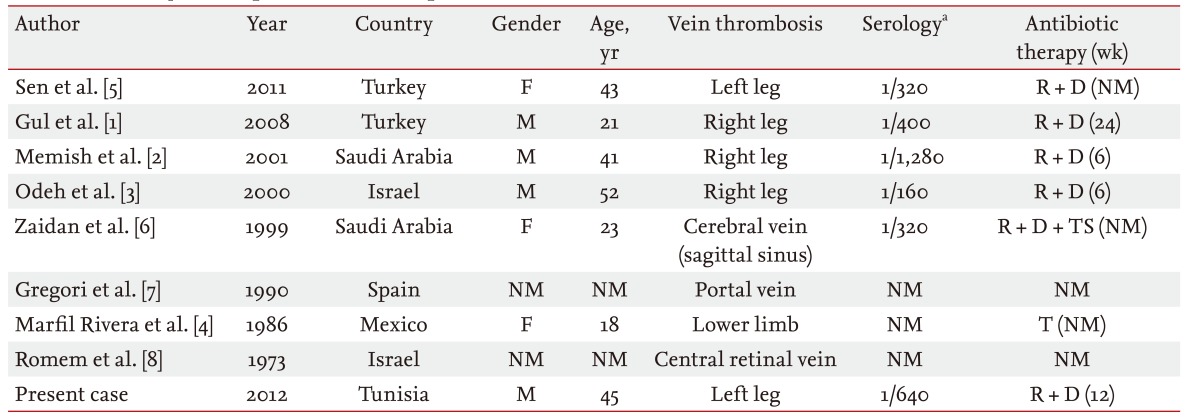 |
 |
| Korean J Intern Med > Volume 28(5); 2013 > Article |
|
To the Editor,
Human brucellosis remains the most common zoonotic disease worldwide, with more than 500,000 new cases annually. It is still a serious and uncontrolled public health problem in many countries, including Tunisia. Human brucellosis is a multisystem disease that may present with a broad spectrum of clinical manifestations and its complications can affect almost all organs and systems, with varying incidence.
Vascular complications of Brucella infection have rarely been reported in the medical literature. By searching MEDLINE, eight cases of deep vein thrombosis (DVT) associated with acute brucellosis have been reported [1-8]. We describe a new case of DVT in the left leg in association with acute brucellosis.
A 52-year-old Tunisian man was admitted to our hospital with a 4-day history of fever and left calf pain associated with myalgia and night sweats. He also reported the ingestion of raw sheep milk. The patient was febrile, to 38.3Ōäā. Homan sign was positive on the left. The circumference of his left calf was 3 cm larger than that of the right. Palpation of the right sacroiliac joint was painful. The rest of the physical examination was unremarkable. A Doppler ultrasound study showed a thrombosis in the left femoral vein. Laboratory examinations revealed the following results: white blood cell count 7,300 cells/mm3 (neutrophils, 49%), platelet count 275,000/mm3, erythrocyte sedimentation rate 30 mm, and C-reactive protein 43 mg/dL. Results of other routine biochemical blood tests were all normal. Protein C, protein S, antithrombin III, and activated protein C resistance activity were within normal ranges, and anticardiolipin and lupus anticoagulant were negative. The chest X-ray and abdominal ultrasound were normal. An anteroposterior X-ray of the pelvis showed grade II sacroiliitis of the right sacroiliac joint. Standard tube agglutination testing of initial samples were positive for antibodies to Brucella (titer, 1/640).
Based on the history of ingestion raw sheep milk, fever associated with myalgia and night sweats, the presence of sacroiliitis, and a positive Wright test, a diagnosis of acute Brucella infection associated with a DVT in the left leg was made. The patient was treated with rifampicin 900 mg/day and doxycycline 200 mg/day combined with low molecular weight heparin. The treatment durations for both anticoagulant and brucellosis were extended to 3 months. After a follow-up period of 9 months, the patient was asymptomatic and, during this period, no recurrence of brucellosis or DVT was observed.
Vascular complications of brucellosis are rare; the arteries are more affected than veins. Arterial complications of brucellosis include aneurysm formation in diverse arteries, such as the aorta, brachial, tibioperoneal, and cerebral arteries, with or without underlying endocarditis. Cutaneous vasculitis has also been noted. Vein thrombosis is a rare vascular complication in acute brucellosis. In 1973, Romem et al. [8] reported the first case of brucellosis complicated with central vein thrombosis. Since this publication, seven further cases of vein thrombosis due to brucellosis have been reported. Table 1 shows demographic data and clinical and laboratory findings of the eight case reports of brucellosis complicated with vein thrombosis. Thrombosis involved the portal vein [7], the central retinal vein [8], the cerebral vein [6], and the lower limb veins [4] in one case each. Acute brucellosis was associated with DVT in the legs in four patients (three men, one woman). The diagnosis of DVT in the leg was made before the onset of other clinical features of brucellosis in one case [2] and concomitant with the diagnosis of brucellosis in two [3,5]. The duration between DVT diagnosis and the occurrence of brucellosis clinical features was 4 weeks. One patient had a history of brucellosis [1].
Suggested mechanisms by which brucellosis may cause DVT include induction of inflammation by the infectious process in adjacent tissues, direct endothelial damage, granulomatous endophlebitis, compression from a local soft tissue mass or abscess, induction of a transient hypercoagulable state, and an immune reaction in the vessel wall to a Brucella antigen. In the present case, protein C, protein S, and antithrombin III levels, and activated protein C resistance activity were normal, and no antiphospholipid antibodies were detected. Also, no local infection adjacent to his left leg deep veins was observed in his illness. Thus, it is possible that granulomatous endophlebitis or a possible immune reaction in the vessel wall to a Brucella antigen was responsible for the patient's DVT.
DVT is a rare complication of brucellosis. We report a new case of leg thrombophlebitis revealing acute brucellosis. The present case and the others reported previously suggest that brucellosis must be considered in patients suffering with DVT, particularly in patients from Brucella-endemic areas.
References
1. Gul H, Mert G, Erdem H, et al. Brucellosis associated with thrombophilebitis: a case report. Am J Case Rep 2008;9:CR31ŌĆōCR33.
2. Memish ZA, Bannatyne RM, Alshaalan M. Endophlebitis of the leg caused by brucella infection. J Infect 2001;42:281ŌĆō283PMID : 11545574.


3. Odeh M, Pick N, Oliven A. Deep venous thrombosis associated with acute brucellosis: a case report. Angiology 2000;51:253ŌĆō256PMID : 10744014.


4. Marfil Rivera LJ, Mares Ramirez MA, Mora Brondo P, Rivera Gonzalez JA, Gomez Almaguer D. Deep venous thrombosis in a patient with brucellosis and a probable lupoid inhibitor: report of a case. Rev Invest Clin 1986;38:311ŌĆō315PMID : 3097779.

5. Sen T, Cagli K, Golbasi Z, Cagli K. Thrombus-in-transit entrapped in a patent foramen ovale: a complication of brucellosis. Turk Kardiyol Dern Ars 2011;39:487ŌĆō490PMID : 21918319.


6. Zaidan R, Al Tahan AR. Cerebral venous thrombosis: a new manifestation of neurobrucellosis. Clin Infect Dis 1999;28:399ŌĆō400PMID : 10064259.






 PDF Links
PDF Links PubReader
PubReader ePub Link
ePub Link Full text via DOI
Full text via DOI Download Citation
Download Citation Print
Print



